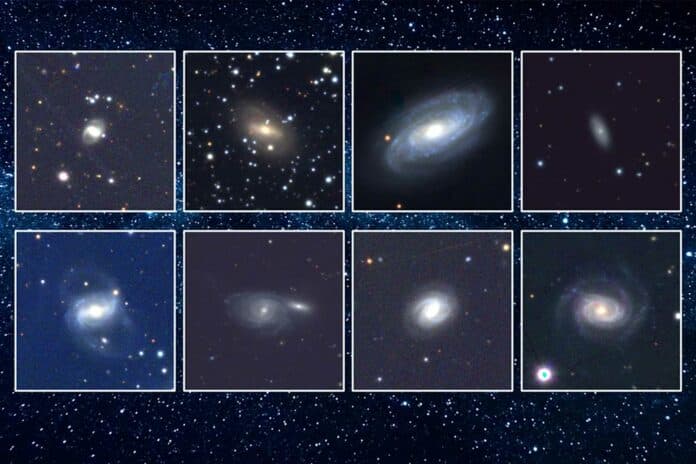Most tidal disruption events (TDEs) are typically discovered through time-domain optical and soft X-ray surveys. However, these observations can be limited due to significant obscuration caused by various factors. In such cases, the infrared (IR) spectrum becomes a powerful tool for studying these events.
Astronomers recently systematically searched NEOWISE mid-IR data for nearby, obscured TDEs. They identified 18 new tidal disruption events (TDEs) — extreme instances when a nearby star is tidally drawn into a black hole and ripped to shreds.
As a black hole consumes material during a tidal disruption event (TDE), it releases a significant burst of energy across the electromagnetic spectrum. Astronomers typically identify TDEs by searching for characteristic bursts in the optical and X-ray bands. So far, these searches have uncovered around a dozen star-shredding events in the nearby universe. However, a team from MIT has expanded this catalog by more than doubling the number of known TDEs.
The MIT researchers discovered these previously unnoticed events by examining an unconventional band: the infrared spectrum. In addition to emitting optical and X-ray bursts, TDEs can produce infrared radiation, especially in “dusty” galaxies with a central black hole surrounded by galactic debris. The dust in these galaxies tends to absorb and block optical and X-ray light, making it challenging to detect TDEs in those bands.
However, the dust heats up in the process, generating infrared radiation that is detectable. The team found that infrared emissions can indicate tidal disruption events, offering a new and valuable method for identifying such occurrences.
The MIT team successfully identified a significantly larger number of tidal disruption events (TDEs) by utilizing the infrared band. This approach allowed them to unveil 18 new TDEs that were previously hidden, occurring in different types of galaxies scattered across the sky.
Lead author Megan Masterson, a graduate student at MIT’s Kavli Institute for Astrophysics and Space Research, said, “Most of these sources don’t appear in optical bands. If you want to understand TDEs and use them to probe supermassive black hole demographics, you need to look in the infrared band.”
For their recent study, the researchers searched for archived observations from NEOWISE, the renewed version of NASA’s Wide-field Infrared Survey Explorer. They employed an algorithm developed by co-author Kishalay De, identifying patterns in infrared emissions indicative of a transient burst of infrared radiation.
The team then cross-referenced the flagged transients with a catalog of all known nearby galaxies within 600 million light-years (200 megaparsecs). This comprehensive search identified about 1,000 galaxies associated with infrared transients.
Next, the researchers examined the signals from each galaxy’s infrared burst to determine if it originated from a source other than a tidal disruption event (TDE), such as an active galactic nucleus or a supernova. After eliminating these possibilities, the team analyzed the remaining signals, searching for an infrared pattern characteristic of a TDE.
This pattern typically involves a sharp spike followed by a gradual dip, reflecting the process where a black hole, in tearing apart a star, rapidly heats the surrounding dust to about 1,000 kelvins before gradually cooling down.
This analysis revealed 18 “clean” signals of tidal disruption events. The researchers surveyed the galaxies in which each TDE was found and saw that they occurred in a range of systems, including dusty galaxies, across the entire sky.
The team’s discoveries address significant questions in the study of tidal disruption events (TDEs). Previously, TDEs were mainly observed in a specific type of galaxy known as a “post-starburst” system, which had been a star-forming region but has since become quiescent. These galaxies are rare, and astronomers were puzzled by the apparent concentration of TDEs in these systems. The reason was that these post-starburst systems are relatively low in dust, making it easier to detect optical or X-ray emissions from TDEs.
However, the MIT team’s use of the infrared band allowed them to detect TDEs in a broader range of galaxies. The new results demonstrate that black holes can consume stars in various types of galaxies, not just post-starburst systems.
Additionally, the findings offer a solution to the “missing energy” problem in TDE observations. Theoretically, TDEs were expected to radiate more energy than observed, but the MIT team suggests that dust might account for the discrepancy. If a TDE occurs in a dusty galaxy, the dust could absorb not only optical and X-ray emissions but also extreme ultraviolet radiation, reconciling the missing energy.
The 18 new TDE detections also contribute to estimating the rate of TDEs in a given galaxy. Combining these new detections with previous ones, astronomers estimate that a universe experiences a tidal disruption event approximately once every 50,000 years. This rate aligns more closely with theoretical predictions. Further infrared observations are anticipated to refine the understanding of TDE rates and the characteristics of the black holes responsible for them.
Journal Reference:
- Parth Potdar et al. ‘High-Speed Tactile Braille Reading via Biomimetic Sliding Interactions.’ IEEE Robotics and Automation Letters (2024). DOI: 10.1109/LRA.2024.3356978
